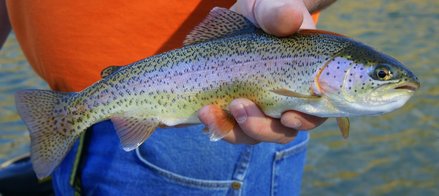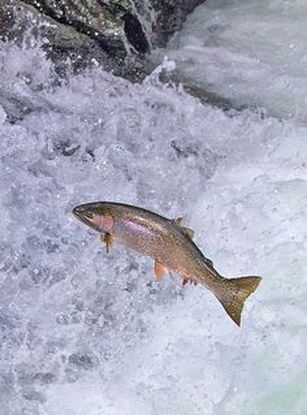 Native to the west coast, managers started stocking rainbow trout out east in the last 1800s to supplement declining brook trout populations. Only, they didn't take off everywhere they had hoped. Native to the west coast, managers started stocking rainbow trout out east in the last 1800s to supplement declining brook trout populations. Only, they didn't take off everywhere they had hoped. Pennsylvania plans to stock over 4.5 million adult trout this year, of which about half will be rainbow trout. Yet, despite such high stocking densities, we don’t see many stocked rainbow trout establishing breeding populations. How could this be? For starters, stocked fish mortality can be upwards of 99%. And, dead fish don’t reproduce (science at its finest!). But, I won’t focus on that today. For a more interesting roadblock, we have to think a little harder about stream ecology and the conditions rainbow trout evolved under. Opposite to brook trout, rainbow trout spawn in early spring from about January-May. In rainbow trout’s native range along the Pacific coast, snowmelt and heavy rains cause consistently high flows during early spring. Predictably high spring stream flows are critical for rainbow trout, as high flows scour the streambed, removing silt, gravel, and debris. Effectively, high flows are the street cleaners that come in after Mardi Gras and prepare the streambed for rainbow trout to spawn. After spawning, predictable summer low flows protect rainbow trout eggs from washing down stream until they can hatch a few months later.  High stream flows are a necessary habitat feature for rainbow trout. High stream flows are a necessary habitat feature for rainbow trout. In short, rainbow trout like predictability. Predictably high flows in winter, and predictably low flows in spring and summer. Now, let’s think about Pennsylvania. Yes, early spring flows are generally higher than summer flows. But, they are far from predictable. One year there might be deep snowpack, the next year there might be no snow at all. Plus, summer flows can be equal to, if not exceed, winter flows. The combination all but assures near 100% mortality for rainbow trout eggs laid in the northeastern United States. Of course, there are exceptions to this statement, and the northeast does have naturally reproducing rainbow trout populations. However, it usually takes some assistance, with most occurring downstream of impoundments (which make flows more predictable) or selectively bred to reproduce in fall. But, the story doesn’t end there. In the southeastern United States, at the southern edge of the brook trout’s native range, climate change is resulting in more frequent winter rain events and summer drought-like conditions. In short, the more predictable stream flows that rainbow trout need for reproduction. Down south, rainbow trout are not only reproducing, but are starting to outnumber brook, and even brown trout. This is, in part, due to rainbow trout’s higher thermal tolerance, but also because high winter flows decrease brook and brown trout egg survival. It’s not uncommon for entire year classes of brown and brook trout to fail because of high winter flows killing eggs. Thinking ahead, with changing climates, could rainbow trout eventually becomes more successful at establishing in the northeast United States? Possibly. And, when if/when they do, we’ll see further declines to not only brook, but also brown, trout populations.
2 Comments
John Kallerson
5/14/2017 09:06:52 am
Reply
Louise Burkholder
12/12/2023 07:40:01 pm
My husband and I were watching "Our Town Raystown Lake" which mentioned that their rainbow trout population could not reproduce. No explanation was offered. After much searching on-line, yours is the clearest, most easily understood answer. Thank -you and what beautiful fish those Raystown swimmers are.
Reply
Leave a Reply. |
AuthorShannon White Archives
October 2018
Categories
All
|
The Troutlook
A brook trout Blog
Proudly powered by Weebly
 RSS Feed
RSS Feed